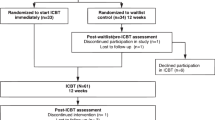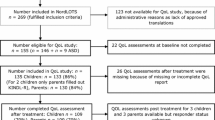Abstract
Cognitive behaviour therapy (CBT) for young people with obsessive compulsive disorder (OCD) has become the treatment of first choice. However, the literature is largely based on studies emphasising exposure and response prevention. In this study, we report on a randomised controlled trial of CBT for young people carried out in typical outpatient clinic conditions which focused on cognitions. A randomised controlled trial compares 10 sessions of manualised cognitive behavioural treatment with a 12-week waiting list for adolescents and children with OCD. Assessors were blind to treatment allocation. 21 consecutive patients with OCD aged between 9 and 18 years were recruited. The group who received treatment improved more than a comparison group who waited for 3 months. The second group was treated subsequently using the same protocol and made similar gains. In conclusion, CBT can be delivered effectively to young people with OCD in typical outpatient settings.


Similar content being viewed by others
References
Abramowitz JS, Whiteside SR, Deacon BJ (2005) The effectiveness of treatment for pediatric obsessive-compulsive disorder: a meta-analysis. Behav Ther 36(1):55–63
Allsopp M, Verduyn C (1989) A follow-up of adolescents with obsessive-compulsive disorder. Br J Psychiatry 154:829–834
Anholt GE, Kempe P, de Haan E, van Oppen P, Cath DC, Smit JH et al (2008) Cognitive versus behavior therapy: processes of change in the treatment of obsessive-compulsive disorder. Psychother Psychosom 77(1):38–42
Asbahr FR, Castillo AR, Ito LM, Latorre MD, Moreira MN, Lotufo-Neto F (2005) Group cognitive-behavioral therapy versus sertraline for the treatment of children and adolescents with obsessive-compulsive disorder. J Am Acad Child Adolesc Psychiatry 44(11):1128–1136
Barrett P, Shortt A, Healy L (2002) Do parent and child behaviours differentiate families whose children have obsessive-compulsive disorder from other clinic and non-clinic families? J Child Psychol Psychiatry 43:597–607
Barrett P, Healy-Farrell L, March JS (2004) Cognitive-behavioral family treatment of childhood obsessive-compulsive disorder: a controlled trial. J Am Acad Child Adolesc Psychiatry 43:46–62
Barrett P, Healy-Farrell L (2003) Perceived responsibility in juvenile obsessive-compulsive disorder: an experimental manipulation. J Clin Child Adolesc Psychol 32:430–441
Bolton D, Luckie M, Steinberg D (1995) Long-term course of obsessive-compulsive disorder treated in adolescence. J Am Acad Child Adolesc Psychiatry 34:1441–1450
Bolton D, Perrin S (2008) Evaluation of exposure with response-prevention for obsessive compulsive disorder in childhood and adolescence. J Behav Ther Exp Psychiatry 39:11–22
Bodden DHM, Bögels SM, Nauta MH, De Haan E, Ringrose J, Appelboom C et al (2008) Child versus family cognitive-behavioral therapy in clinically anxious youth: an efficacy and partial effectiveness study. J Am Acad Child Adolesc Psychiatry 47(12):1384–1394
De Haan E, Hoogduin KAL, Buitelaar JK, Keijsers GPJ (1998) Behavior therapy versus clomipramine for the treatment of obsessive-compulsive disorder in children and adolescents. J Am Acad Child Adolesc Psychiatry 37:1022–1029
Derisley J, Libby S, Clark S, Reynolds S (2005) Mental health, coping and family-functioning in parents of young people with obsessive-compulsive disorder and with anxiety disorders. Br J Clin Psychol 44:439–444
Douglass HM, Moffitt TE, Dar R, McGee R et al (1995) Obsessive-compulsive disorder in a birth cohort of 18-year-olds: prevalence and predictors. J Am Acad Child Adolesc Psychiatry 34:1424–1431
Foa EB, Kozak MJ, Salkovskis PM, Coles ME, Amir N (1998) The validation of a new obsessive-compulsive disorder scale: The Obsessive-Compulsive Inventory. Psychol Assess 10:206–214
Foa EB, Liebowitz MR, Kozak MJ, Davies S, Campeas R, Franklin ME, Huppert JD, Kjernisted K, Rowan V, Schmidt AB, Simpson HB, Tu X (2005) Randomized, placebo-controlled trial of exposure and ritual prevention, clomipramine, and their combination in the treatment of obsessive-compulsive disorder. Am J Psychiatry 162:151–161
Gallop C (2009) Cognitive behavioural assessment of OCD. In: Waite PL, Williams TI (eds) Obsessive compulsive disorder: cognitive behaviour therapy with children and young people. Routledge, London
Geller DA, Biederman J, Stewart SE, Mullin B, Martin A, Spencer T, Faraone SV (2003) Which SSRI? A meta-analysis of pharmacotherapy trials in pediatric obsessive-compulsive disorder. Am J Psychiatry 160:1919–1928
Kovacs M (1992) The children’s depression inventory manual. Multi-Health Systems, Toronto
Libby S, Reynolds S, Derisley J, Clark S (2004) Cognitive appraisals in young people with obsessive-compulsive disorder. J Child Psychol Psychiatry 45:1076–1084
March JS (1997) Technical manual for the multidimensional anxiety scale for children (MASC). Multi-Health Systems, New York
March JS, Frances A, Carpenter D, Kahn MD (1997) Treatment of obsessive-compulsive disorder. The Expert Consensus Panel for obsessive-compulsive disorder. J Clin Psychiatry 58(Suppl 4):2–72
March JS, Foa E, Gammon P, Chrisman A, Curry J, Fitzgerald D, Sullivan K, Franklin M, Huppert J, Rynn M, Zhao N, Zoellner L, Leonard H, Garcia A, Freeman J, Tu X (2004) Cognitive-behavior therapy, sertraline, and their combination for children and adolescents with obsessive-compulsive disorder—the Pediatric OCD Treatment Study (POTS) randomized controlled trial. J Am Med Assoc 292:1969–1976
Mather A, Cartwright-Hatton S (2004) Cognitive predictors of obsessive-compulsive symptoms in adolescence: a preliminary investigation. J Clin Child Adolesc Psychol 33:743–749
Matthews L, Reynolds S, Derisley J (2006) Examining cognitive models of obsessive compulsive disorder in adolescents. Behav Cogn Psychother 35(02):149–163
Morris SB, DeShon RP (2002) Combining effect size estimates in meta-analysis with repeated measures and independent-groups designs. Psychol Methods 7:105–125
National Collaborating Centre for Mental Health (2006) Obsessive compulsive disorder: core interventions in the treatment of obsessive compulsive disorder and body dysmorphic disorder. National Clinical Practice Guideline Number 31. The British Psychological Society, The Royal College of Psychiatrists, London
O’Kearney RT, Anstey KJ, von Sanden C (2006) Behavioural and cognitive behavioural therapy for obsessive compulsive disorder in children and adolescents. Cochrane Database Syst Rev, no. 4, art. no. CD004856. doi:10.1002/14651858.CD004856.pub2
Reynolds S, Reeves J (2008) Do cognitive models of obsessive compulsive disorder apply to children and adolescents? Behav Cogn Psychother 36(04):463–471
Salkovskis PM (1998) Psychological approaches to the understanding of obsessional problems. In: Swinson RP, Antony MM, Rachman SJ, Richter MA (eds) Obsessive-compulsive disorder: theory, research and treatment. Guilford, New York
Salkovskis PM (1999) Understanding and treating obsessive-compulsive disorder. Behav Res Ther 37:s29–s52
Salkovskis P, Wroe A, Gledhill A, Morrison N, Forrester E, Richards C, Reynolds M, Thorpe S (2000) Responsibility attitudes and interpretations are characteristic of obsessive compulsive disorder. Behav Res Ther 38:347–372
Scahill L, Riddle MA, McSwiggin Hardin M, Ort SI, King RA, Goodman WK, Cicchetti D, Leckman JF (1997) Children’s Yale-Brown Obsessive Compulsive Scale: reliability and validity. J Am Acad Child Adolesc Psychiatry 36:844–852
Silverman WK, Albano AM (1996) Anxiety disorders interview schedule for DSM-IV: child and parent versions. The Psychological Corporation, San Antonio
Simpson HB, Franklin ME, Cheng JF, Foa EB, Liebowitz MR (2005) Standard criteria for relapse are needed in obsessive-compulsive disorder. Depression Anxiety 21:1–8
Thomsen PH, Mikkelsen HU (1995) Course of obsessive compulsive disorder in children and adolescents. A prospective follow-up study of 23 Danish cases. J Am Acad Child Adolesc Psychiatry 34:1432–1440
Williams T, Salkovksis P, Forrester EA, Allsopp MA (2002) Changes in symptoms of OCD and appraisal of responsibility during cognitive behavioural treatment: a pilot study. Behav Cogn Psychother 30:69–78
Acknowledgments
This research was supported by a grant (SPGS 808) from the National Health Service Responsive Funding Scheme to the first author.
Author information
Authors and Affiliations
Corresponding author
Rights and permissions
About this article
Cite this article
Williams, T.I., Salkovskis, P.M., Forrester, L. et al. A randomised controlled trial of cognitive behavioural treatment for obsessive compulsive disorder in children and adolescents. Eur Child Adolesc Psychiatry 19, 449–456 (2010). https://doi.org/10.1007/s00787-009-0077-9
Received:
Accepted:
Published:
Issue Date:
DOI: https://doi.org/10.1007/s00787-009-0077-9




